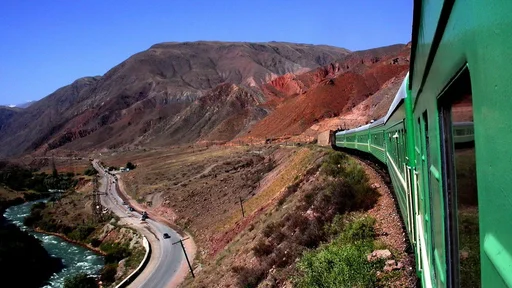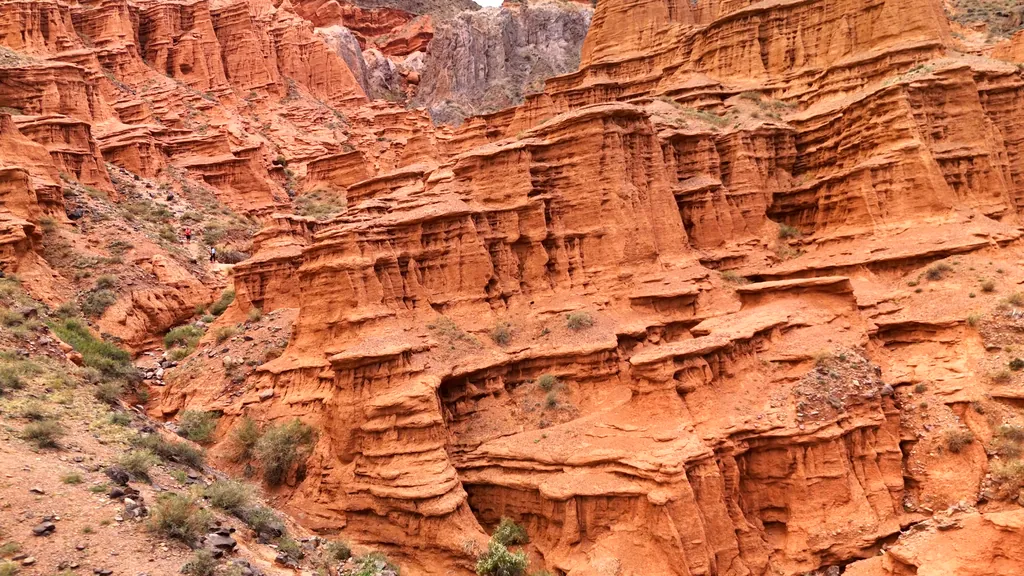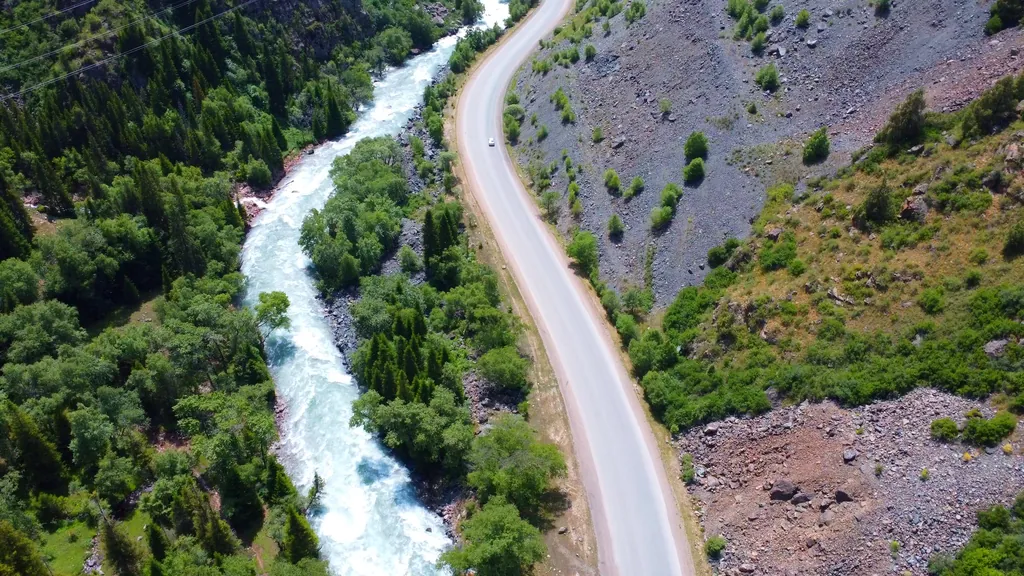Forgotten Rivers and Mountain Peaks: A Journey Along the Southern Shore of Issyk-Kul is a three-day tour that immerses you in the unique natural beauty of Kyrgyzstan.
- Duration: 3 days.
- Price: from 1300$ 1000$ for group
- Group size: Small group tour

Boom Gorge is located in northern Kyrgyzstan, approximately 112 km east of Bishkek, and serves as the only transport corridor between the Chuy Valley and the Issyk-Kul Basin. The gorge follows the middle course of the Chu River, which cuts through the mountain range between the western Kyrgyz Ala-Too ridge and the eastern Kungey Ala-Too ridge. The gorge spans about 30 km and essentially represents a deep tectonic fault within the Tien Shan mountain system. It is through this rift that the Chu River turns northward, exiting the mountains into the broad Chuy Valley and continuing its flow toward Kazakhstan.
Geologically, Boom is composed of a variety of rock types. The steep gorge slopes consist of granites, porphyries, and conglomerates that plunge toward the rushing river, forming talus slopes. In some locations, exposures of volcanic rocks appear - for example, near the mouth of the Suluterek River on the left bank, Cretaceous-Paleogene basalts have been identified. A major tectonic fault (the Toguzbulak Fault) runs along the gorge floor and played a key role in carving out this valley. The modern landscape of the gorge was shaped by recent uplift and the erosive action of the Chu River cutting through the mountains.
Interestingly, in prehistoric times Boom Gorge may have served as a natural outflow channel for Lake Issyk-Kul. One hypothesis suggests that a catastrophic breach of the overfilled lake once sent floodwaters surging through the fault (the present-day Boom Gorge), causing a deluge across the Kyrgyz steppes and dramatically lowering the lake level. Ancient accounts indicate that at times the Chu River received powerful inflows from Issyk-Kul and even reached the Syr Darya. Today, however, the lake has no outlet, and the Chu River flows separately through the gorge, skirting the lake’s eastern edge near the Kochkor Valley. The upper, wider section of Boom features relatively gentle relief, where the river forms a floodplain with woody shrubs, whereas the lower section narrows into a canyon with sheer cliffs through which the Chu meanders.


Boom Gorge has long served as a natural mountain pass between northern and eastern parts of Kyrgyzstan. As early as the Middle Ages, a route from the Chuy Valley to Issyk-Kul passed through it: branch routes of the Great Silk Road linking ancient towns such as Suab (Ak-Beshim), Navoiy (Krasnaya Rechka), and Balasagun (Burana) with the shores of Issyk-Kul transited this narrow Boom corridor. However, the road through Boom was always known for its difficulty and dangers. The name “Boom” in Kyrgyz literally means “evil spirit” - according to legend, the gorge was so named because of the hardships and trials that awaited every traveler here. Steep cliffs, rockfalls, and a turbulent river made the path almost impassable.
In 1850, the Russian explorer Pyotr Semyonov (later known as Semyonov-Tyan-Shansky) became the first European to venture through Boom Gorge and experience its perils firsthand. Semyonov’s expedition required 21 days to traverse roughly 22 km of the mountain canyon. He described Boom as a “deadly trap,” where the path vanished beneath sheer cliffs - forcing him to scramble up rock faces - and in other spots he had to wade through the rushing river, risking being swept away. Nevertheless, Semyonov-Tyan-Shansky’s research dispelled the prevailing misconception about the region’s hydrology: the Chu River does not flow out of Lake Issyk-Kul as previously thought, but rather skirts the eastern flank of the Kyrgyz Ridge, originating in the Naryn mountains and running separate from the lake.
Only two decades later, from 1871 to 1873, the first wheeled road following Semyonov’s route was constructed through Boom Gorge. Building this road during the Tsarist era was a major engineering feat for its time. The narrow dirt track traced the Chu River’s meanders - sometimes hugging the riverbank and at other times winding serpentinely up the slopes. To cross the river, a wooden bridge was erected in 1873 at the gorge’s midpoint, known as the Kok-Moinok Bridge. With the completion of the road, travel through Boom became significantly easier, connecting the Tien Shan regions of the Russian Empire.
During the Soviet period, the importance of the Boom pass grew even further. In 1948, a railway line from Frunze (Bishkek) to Rybachye (now Balykchy) was laid through the gorge, forming a key segment of the Turkestan-Siberia Railway. The first train traversed this 189 km branch in 1948. The Bishkek-Issyk-Kul highway was also upgraded, replacing the old dirt track with an asphalt road. In Soviet decades, entry into the Issyk-Kul resort region was tightly controlled - travelers required a sanatorium voucher, and long queues often formed at the traffic checkpoint (GAI) before Boom. Boom Gorge effectively acted as the “gateway” to the lake region, channeling the entire tourist and sanatorium flow.
After the USSR’s dissolution, travel restrictions were lifted, and today vehicles pass freely through the former checkpoint. In the late 1990s and early 2000s, the Boom road underwent major reconstruction and widening. By the early 21st century, the route had become a modern highway and is now considered one of Kyrgyzstan’s best roads. A local anecdote recalls that the very first attempt to drive the new Bishkek-Balykchy highway ended when the vehicle ran out of fuel in the gorge. Following this incident, a gas station was installed near the bridge over the Chu to prevent travelers from becoming stranded. Today, Boom Gorge remains a strategically vital pass, carrying thousands of passengers and tons of cargo daily between the country’s northern (Chuy) and eastern (Issyk-Kul) regions.


The national A365 highway runs through the gorge, linking Bishkek with Balykchy on the western shore of Issyk-Kul. This road provides the only convenient overland connection from the north to the lake resorts, serving as the primary artery into the basin from the west. The asphalt route features guardrails, reinforced embankments, and a moderate ascent that reaches the Kok-Moinok Pass at the gorge exit. Following reconstructive work in the 2000s, the highway now offers high quality and capacity. In narrow sections where the road once clung to cliffs, new alignments have been cut into safer terraces. The middle portion of the gorge marks the border between Chuy and Issyk-Kul regions, denoted by the famous “Red Bridge” over the Chu River. Originally a wooden structure in the 19th century, the modern metal bridge - painted red - now serves as the administrative boundary between the two regions.
Along the highway’s upper (western) section lie several roadside villages and tourist stops. Small cafés, teahouses, and stalls cater to travelers here. Near the Red Bridge, a turnoff leads onto a dirt road into the side canyon of Konorchek. This road winds toward the famous aeolian canyons of Konorchek (about 20 km from the main road) and continues via the Kok-Moinok II Pass into the Kochkor Valley. Thus, Boom Gorge functions as a road junction: the main highway leads to Issyk-Kul, while side branches connect to Naryn Region (via the Kochkor Pass) and various local attractions (canyons, the Orto-Tokoy Reservoir).
In addition to the roadway, a railway line from Bishkek to Balykchy runs along the opposite bank of the Chu River. Elevated on the slopes, it even crosses above the highway in places. Built in the mid-20th century, the line originally served to transport industrial goods to Issyk-Kul. Today, service on this branch is limited: occasional freight trains and seasonal passenger services operate to the lake. Nonetheless, the presence of both road and rail emphasizes Boom Gorge’s critical role in the national transport network. No other Kyrgyz gorge carries two major transport arteries in parallel, making Boom unique.
Given heavy traffic, protective measures guard the road from natural hazards. Concrete retaining walls and gabion structures line the most vulnerable sections to shield against rockfalls and landslides. Galleries and mesh barriers have been installed on slopes. Yet extreme weather occasionally overwhelms defenses: heavy rains can trigger debris flows that temporarily block the road, and fallen rocks require clearance. Despite these challenges, the highway through Boom remains a lifeline. Traffic surges in summer as vacationers flood to Issyk-Kul, creating dense two-way flows. The gorge truly feels like “gateways” directing the traffic into the resort region. Authorities recognize Boom’s strategic importance - road and bridge maintenance here is a high priority, since no shorter alternate routes exist. Any repair works are carefully scheduled to keep the Chuy and Issyk-Kul regions connected.
Boom Gorge has long inspired legends and folklore reflecting its forbidding nature. The toponym “Boom” literally means “evil spirit” or “ghost” in Kyrgyz. According to one tradition, ancient nomads believed a malevolent spirit dwelled in the gorge’s narrow defile, bringing misfortune to travelers. Hence the name - people tried to appease the spirit or avoid the treacherous pass. More commonly, however, “Boom” simply reflects the hardship of traversing the pass, as though supernatural forces conspired against every crossing.
Unsurprisingly, ghost stories abound. A modern tale among drivers speaks of the “Lady in Red” - a phantom said to appear to lone male motorists traveling through the gorge at night. The legend holds that any man driving alone through Boom will see a mysterious woman in red appear beside him, after which misfortune inevitably follows. Supposedly, long ago, an unfaithful husband brought his mistress here and murdered her near Kyz-Kuyuu village in the gorge; the woman’s spirit now haunts the road, seeking vengeance on unfaithful and solitary travelers. Some claim to have seen a female silhouette along the dark highway, though no grave or other proof has been found. Still, the “Lady in Red” story is firmly entrenched in Boom’s modern driver lore.
Another well-known legend involves the locality and small village of Kyz-Kuyuu (“Bride and Groom”) in Boom Gorge. According to tradition, a wealthy clan chief’s beautiful daughter from the Ton region of Issyk-Kul fell in love with a poor herder working for her father. Opposing their union, the chief arranged a different match, so the lovers attempted to flee. The young man carried the maiden on horseback toward the Chuy Valley, but enraged kin pursued them. The couple was caught in the gorge’s rocky maze - separated when the lovers took different riverbanks - and mercilessly slain on the spot. Wherever their innocent blood was shed, two springs sprang forth, and the place was named Kyz-Kuyuu in memory of their tragic love.


Boom Gorge is not only a transport artery but also an appealing eco-tourism and adventure destination. Renowned for its rugged, majestic landscapes, Boom is often called the “calling card” of the route to Issyk-Kul and the “gateway” to the lake valley. Virtually every traveler heading to Issyk-Kul passes through the gorge and has the opportunity to admire its scenery. Many stop at roadside viewing platforms and cafés. Symbolic sculptures - of the snow leopard, golden eagle, and deer - welcome visitors, underscoring the wild spirit of the Tien Shan. These statues have become beloved photo backdrops for tourists entering the gorge.
Boom also attracts adventure seekers. Whitewater rafting on the Chu River through the gorge is considered among Kyrgyzstan’s best. The river’s rapids of moderate difficulty offer thrilling yet relatively safe descents for organized groups. Each rafting season (May-June when the river is at peak flow), hundreds of rafting and kayaking enthusiasts tackle the Boom stretch. The gorge also offers hiking and trekking. Off the main highway lie the scenic Konorchek Canyons - a labyrinth of red sandstone castles and pillars sculpted by wind and water. A 5-6 km trek along a dry riverbed leads to these fantastic rock formations reminiscent of ancient ruins. A day hike into Konorchek provides a deeper immersion in the wild spirit of the Boom mountains, away from the busy highway.
For those wishing to stay overnight, camping options abound. Tent sites and glamping camps set up along the Chu, often accompanied by yurt encampments offering lodging and traditional cuisine. In the evenings, travelers gather around campfires, listening to the Chu’s roar and marveling at the star-filled sky above the narrow canyon walls - an unforgettable eco-tourism experience.
Despite its development, Boom retains a sense of wildness. Experienced guides recommend stopping at the Red Bridge and descending to the riverbank for the full sensory impact of the gorge: boulders polished by the current, the river’s roar between sheer cliffs, and echoes dancing off stone walls. Boom Gorge is not merely a transit route but a standalone destination, where history, nature, and modern infrastructure converge to offer a unique experience to every visitor.


Boom Gorge lies in a transition zone between mountain and steppe climates, resulting in diverse ecosystems. In the upper, wider section, the Chu River forms a floodplain with sufficient moisture to support dense stands of poplars and thickets of wild rose and hawthorn. Higher on the slopes, juniper (archa) shrubs typical of the mid-elevations of the Tien Shan flourish. Thanks to the river, this part of the gorge appears as a green oasis amid sun-scorched hills. In contrast, the lower Boom narrows into a canyon that is much drier and rockier. Vegetation there is sparse: only hardy shrubs and grasses emerge from cracks in reddish-brown cliffs. Nevertheless, nature persists even under these harsh conditions: wormwood patches and flocks of swift mountain birds can still be seen along the valley.
The gorge’s fauna typifies the Northern Tien Shan, though few large mammals remain due to road proximity. In Soviet times, the area formed part of the snow leopard’s (irbis) range - hence the leopard sculptures at the gorge entrance. Today, snow leopards are found only higher in the Kungey Ala-Too, away from human activity. Lynx and wolves occasionally roam the gorge by night, calling across the slopes. Steep cliffs host ibex and Siberian goats, while roe deer sometimes graze in the floodplain. The Chu River supports fish - primarily marinka and osman species - though heavy rafting and unregulated fishing have impacted their numbers. Overall, the gorge’s ecosystem remains fragile: the busy highway, noise, and roadside litter place continuous pressure on the natural environment.
Forgotten Rivers and Mountain Peaks: A Journey Along the Southern Shore of Issyk-Kul is a three-day tour that immerses you in the unique natural beauty of Kyrgyzstan.
Skiing, mountains, and the winter atmosphere of Kyrgyzstan. A one-day ski trip to Orlovka – skiing near Bishkek
Experience all the beauty of Kyrgyzstan's nature behind the wheel of a comfortable and daring BMW F650GS tour enduro. These impressions are worth any money and will never be forgotten.
In 3 days we will travel around Lake Issyk-Kul. We will spend two days in the city of Karakol, devoting them to skiing at the ski resort. And we will also relax in the thermal springs!
Visit two pearls of Kyrgyzstan in 1 day on a car tour
Visit the Valley of the Seven Bulls, see Issyk-Kul and relax in the thermal springs
This route combines the picturesque mountain canyons of Kok-Moinok, Lake Issyk-Kul, the taste of national cuisine and a trip along one of the most beautiful roads in the country – the Boom Gorge.